
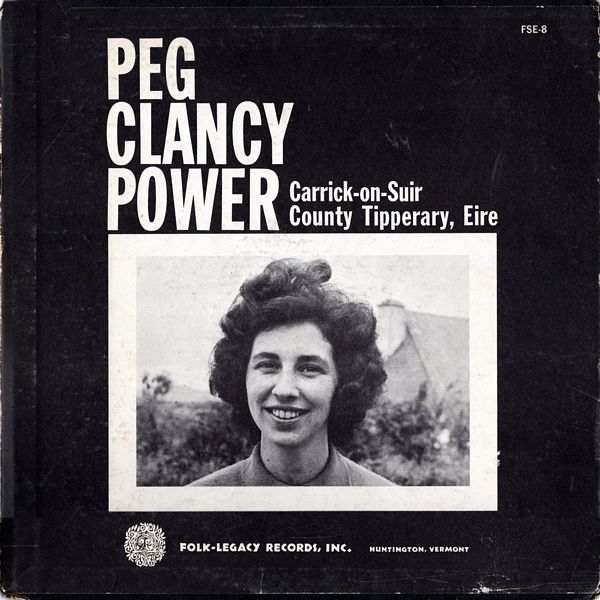 |
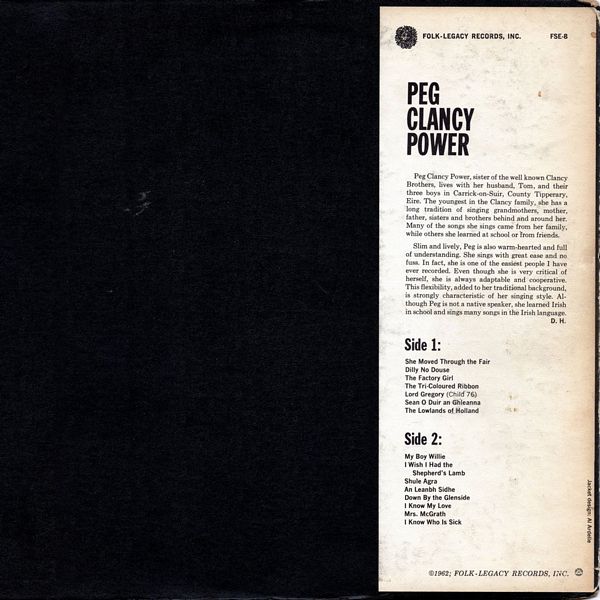
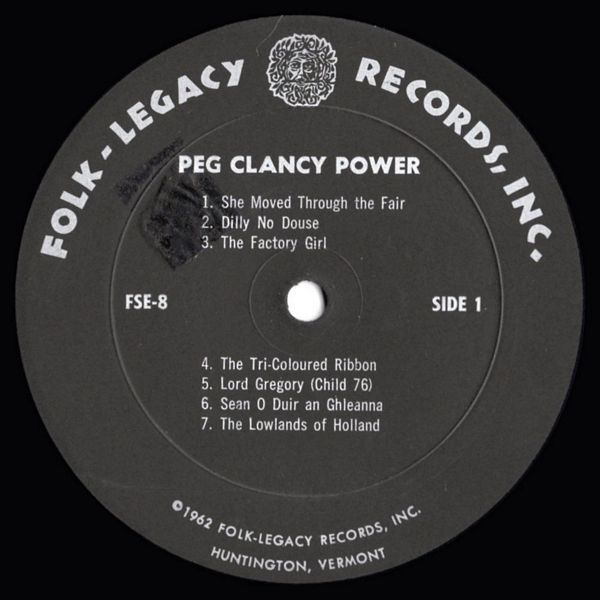
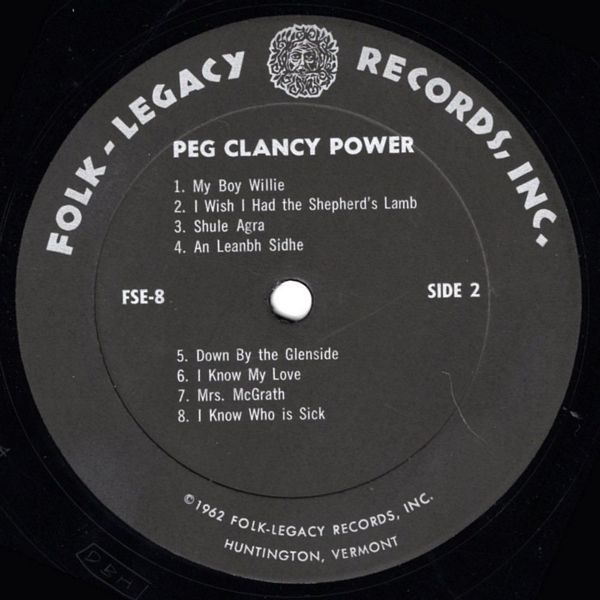
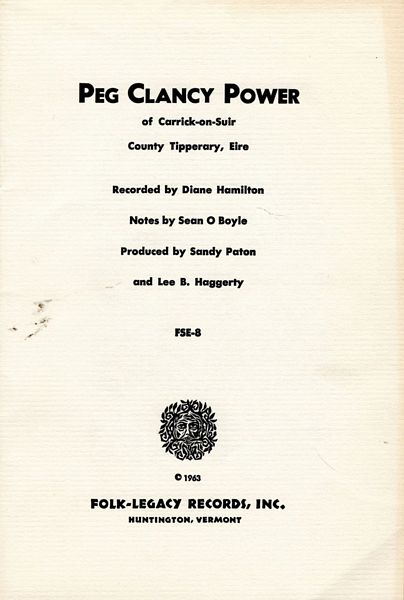 |
Sleeve Notes
PEG CLANCY POWER
Late this afternoon, I stopped in to see Peg Power and her family. For awhile, Peg and I sat by the fire and talked about songs and collecting. Then her husband, Tom, came in from his work in the tannery and the conversation turned to bullocks and wheat. After tea, while Tom and I continued talking, Peg started to get the children washed and off to bed, so they would be ready for Sunday Mass the next morning. Young Owen ( age three), who looks very much like his mother with large, dark eyes, black hair, and a gay smile, was put up onto the table to have his hair cut. This required a great deal of tact and persuasion, as every time Peg touched Owen's neck with the cold scissors he giggled and squirmed. In the end, she warmed the scissors at the fire and told him stories to keep him quiet while she snipped a piece here and there. Next, Kevin ( age ten) came bursting into the room, all aglow over the first hurling match which his team had won. All this time, Bobby ( age eight) was cutting " forts" out of a karge sheet of brown paper. " Who's going to take the first bath?" Peg asked. In the end, they had " to toss" to decide which could " stay out 'til last."
Peg is a sister of the well known Clancy Brothers. She and her husband live with their three boys in Carrick-on-Suir, County Tipperary, Eire. The youngest in the Clancy family, Peg has a long tradition of singing grandmothers, mother, father, sisters and brothers behind and around her. Many of the songs she sings come from her family, while others were learned at school or from friends.
Slim and lively, Peg is also warm-hearted and full of understanding. She sings with great ease and no fuss. In fact, she is one of the easiest people I have ever recorded. Even though she is very critical of herself, she is always adaptable and cooperative. This flexibility, added to her traditional background, is strongly characteristic of her singing style. Although Peg is not a native speaker, she learned Irish in school and sings many songs in the Irish language.
Peg recently recorded for Connisseur Records, singing with her brother, Bobby, and is often heard on Radio Eireann. Last summer she sang with her brothers and Tommy Makem at the Edinburgh Festival in Scotland. As well known for her acting as for her singing, she has appeared in many Carrick-on-Suir Drama Club plays. In 1961, she won the Cork Drama Prize for the " best actress" of the year.
Diane Hamilton
SHE MOVED THROUGH THE FAIR — This old song has been largely re-written by Padraic Colum (1884-), an Irish poet who has for many years been living in America. He collaborated with the Irish musician, Herbert Hughes, who first published "She Moved Thro' the Fair" in Irish Country Songs (Boosey & Co.). This sophisticated version of the older County Antrim folk-song has been made popular throughout the English-speaking world by Sidney McEwan, tenor. It is sung here by Peg Clancy Power, because in her part of the world, the words written by Padraic Colum have superseded the original folk-song version.
DILLY NO DOUSE (Dilin O Deamhas) — This is a little dandling song in. Gaelic. It is one of the many light-hearted songs recently popularized by those interested in the Gaelic revival and just as recently absorbed into the folk repertoire. The words are to be found in An Corsair Ceoil (The Singing Group), published by An Claisceadal, Dublin. The melody is Sol Mode, Hexatonic …
THE FACTORY GIRL — Long before the establishment of factories for the manufacture of linen in Ulster, the people of the countryside were expert in the arts of home-spinning and home-weaving. With the coming of the Industrial Revolution, these people moved into the towns and cities and readily adapted their skills to the service of the machines. Their mental attitudes, however, were still those of country folk, their traditions of song-writing and story-telling and communal activities were still strongly rural and fundamentally Gaelic. Hence the appearance in our folk-repertoire of such a song as "The Factory Girl". In form and expression, it is a nineteenth century version of the Gaelic "Aisling", or Vision Poem — the industrial setting is new, but the events are stereotyped and traditional.
Notice the early morning walk of the poet and the sudden appearance of the Vision. The maiden is fairer than Venus. Her cheeks are like the roses and her skin like the lily. She is seen as a hard-working factory girl, who, when approached by the poet, reveals (in Peg Power's version) that she has gold and silver of her own and will never again need to answer the factory bell.
In the Ulster version of this song, as sung by Sarah Makem of Keady, County Armagh, the traditional links with the Gaelic "Aisling" appear most clearly and the communal spirit of the urbanized country folk is reflected in the last verse …
THE TRI-COLOURED RIBBON — This song sprang out of the Irish Revolutionary Movement (1916 - 1922). Though of such recent origin, its appeal to the country singer is really founded on its use of a very ancient folk-theme. In Percy's Rellques of Ancient English Poetry, we find "The Willow Tree, A Pastoral Dialogue" …
In time, this theme took many shapes and finally crystallized into: "All 'round my hat, I wear the green willow." One of the best of Ireland's Revolutionary versifiers, a Dublin house painter called Peadar Kearney (1890 - 1940), took the English folk-song as his model, replaced the green willow with the green-white-and-yellow ribbon, and made this song.
LORD GREGORY (Child 76) — This old Scots ballad owes its present popularity in Munster to the singing of Mrs. Elizabeth Cronin of County Cork, who recorded it for Seamus Ennis. The air used by Mrs. Cronin, and now sung by Peg Power, is an Irish one generally associated with the ballad "Young Molly Bawn" or "The Shooting of his Dear" (Irish Street Ballads, p. 58).
The full story of Lord Gregory does not emerge from Peg's singing, but it can be found in Child's The English and Scottish Popular Ballads, under the title of "The Lass of Roch Royal". In Gavin Greig's Last Leaves of Aberdeenshire Ballads (Aberdeen, 1925), the ballad is properly titled "Lord Gregory" and two versions of both words and music are there given. Each version has twenty- eight verses, of which these few may serve to tell the story …
SEÁN O DUIR AN GHLEANNA ("John O Dwyer of the Glen") — Colonel John O Dwyer, a seventeenth century Irish soldier, of Glynn, County Waterford, was known to his followers as Seán O Duir an Ghleanna — John O Dwyer of the Glen. After the defeat of the Irish in Waterford and Tipperary in 1651, he sailed for Spain with five hundred of his men. The song laments his departure and makes special reference to the English military policy of that day, i.e., the cutting down of Irish forests to expose native troops. This reckless destruction of Irish woods was such a feature of the seventeenth century that a French traveller could later write:
"(Ireland) is now almost destitute of trees; and when, on a fine day in spring, it appears, though bare, full of sap and youth, it seems like a lovely girl deprived of her hair."
A contemporary Irish ballad (Cill Cais) also asks:
"What shall we do for timber? The last of the woods is laid low."
"Seán O Duir an Ghleanna" is as much a lament for this wanton denudation as it is for the departure of the gallant Colonel.
THE LOWLANDS OF HOLLAND — This song of the Press Gang is a Scots song naturalized in Ireland. Hence, being an Irish singer, Peg Power naturally sings of "Galway" where the original text speaks of "Galloway".
The Holland in the song Is, of course, New Holland of the East Indies:
Where the sugar cane is plentiful
And the tea grows on each tree.
Versions of "The Lowlands of Holland" are to be found in every part of Britain and Ireland where folk-singers still remain. Texts with various tunes have been published in Folk Songs from Somerset (No. 44), Herbert Hughes' Irish Country Songs (Vol. II, 70) and Joyce's Old Irish Folk Music and Songs (p. 214). Cecil Sharp collected a fragmentary version of it at Nash, Virginia, and published it in English Folk Songs from the Southern Appalachians, Vol. I (p. 200).
The beautiful air used here comes from the Donegal- Fermanagh border and was first recorded by Paddy Tunney, Ireland's "Man of Songs" (Folk-Legacy Records, Inc. has recently issued a solo album of Paddy Tunney — FSE-1).
MY BOY WILLIE — Known also as "The Sailor Boy", this song is sung all over the English-speaking world with many variants of words and music. Its first line: "Early, early all in the spring", is the opening phrase of numerous other ballads, notably "Died for Love" and, in Ireland, "The Croppy Boy", Along the Mississippi, it is known as "The Pinery Boy".
The air sung by Peg Power was published, without words, as long ago as 1840, under the title of "Charlie Reilly" or "The Robber", by Edward Bunting in his famous collection — Ancient Irish Music. The most recent printing of words and music is in Colm O Lochlainn's Irish Street Ballads (Three Candles Press, Dublin).
I WISH I HAD THE SHEPHERD'S LAMB — To counter-balance the Gaelic version of "The Angel's Whisper" (see "An Leanbh Sidhe", Side II, Band 4) by Lover, Peg here sings an old, popular free translation of a playful little Gaelic song called "Is trua gan peata'n Mhaoir agam". In Old Irish Folk Music and Song (p. 238), Joyce gives three verses with the Gaelic chorus written phonetically.
SHULE AGRA — This beautiful song has reference to the period following the Williamite wars at the end of the seventeenth century. It speaks of the grief of a young girl whose sweetheart has left Ireland with the remnants of the defeated Irish army, after the signing of the Treaty of Limerick (1691). It is also called "Shule Aroon" and is so named by Joyce in Old Irish Folk Music and Song (p. 236).
The chorus, which has all the appearance of having belonged to an earlier Gaelic "elopement song", can be translated:
Come, come, come my dear;
Gently come and softly, dear.
Come to the door and make off with me
And may thy journey go well with thee.
This song, on the lips of Irish exiles in America, has finally taken the form of "Johnny Has Gone for a Soldier". In this connection, it is interesting to compare the sounds of the Gaelic chorus in "Shule Aroon" with the nonsensical jingle-chorus of the American song (see Burl Ives1 Song Book). The last two verses of Peg's version are additions to the original ballad from the pen of Alfred Perceval Graves (1846-1931), father of the modern poet, Robert Graves. (See Irish Song Book, by A. P. Graves)
AN LEANBH SIDHE ("The Fairy Child") — Samuel Lover (1797 - 1868) was one of the most popular song-writers of nineteenth century Ireland. His songs were all written in English and the most of them he adapted to genuine Irish airs. At least one of them, "The Angel's Whisper", has been utilized in translation for the spread of the Irish language. Peg learned it at school and sings it here.
DOWN BY THE GLENSIDE — Of all the songs written by Peadar Kearney, this one, in form and atmosphere, is truest to Irish tradition. It is hard to believe that it belongs, not to the period of the Fenian Movement, but to the more recent twentieth-century Revolution. The allegorical representation of Ireland as an old woman is a well-known poetical device in Irish literature. One thinks of the Shan Van Vocht, the Poor Old Woman of '98, and of Pearse's "Miss Eire". Peadar Kearney wrote his verses to the tune of one of Samuel Lover's songs, well-known in the streets of Dublin - "If all the Young Maidens were Blackbirds and Thrushes". It was to Lover's words that I first heard the air sung, in Belfast, over forty years ago. Kearney's words first gained real recognition when sung by Delia Murphy in the nineteen-forties. The tune is La mode, hexatonic.
I KNOW MY LOVE — Herbert Hughes has published this song with music in Irish Country Songs. Vol. I. Extra verses are to be found in The Book of Irish Ballads, p. 122 (edited by Daniel O Keefe, Mercier Press, Cork, Ireland). Peg's second verse should be compared with the English folk-song "There is a Tavern in the Town". The tune is in the Doh mode.
MRS. McGRATH — Speaking of this song, as published in Irish Street Ballads (p. 192), Colm O Lochlainn says it is ''known to every true born citizen of Dublin. In the years 1913 - 16, it was the most popular marching song of the Irish Volunteers." The tune to which the Volunteers marched is here replaced by a much superior traditional air from Munster. The general theme of the ballad should be compared with that of "Johnny, I Hardly Knew You".
I KNOW WHO IS SICK — Except for verbal variations in the first verse, we have here the folk-song generally known as:
I know where I'm goin'
And I know who's go in' wi' me;
A wee lad of my own
And they call him Freestone Jimmy.
(from my mother)
Herbert Hughes has a setting of this song in Irish Country Songs. Vol. I, and the words are printed without music in The Book of Irish Ballads by O Keefe. The attractive air sung by Peg Power has not hitherto been recorded.
FOLK-LEGACY RECORDS, INC., was established in 1961 by Lee B. Haggerty, Mary W. Haggerty and Sandy Paton. Although we will, from time to time, issue records of exceptional "interpreters" of traditional music and tales, our primary purpose is to make good field recordings of authentic traditional artists available to the general public.